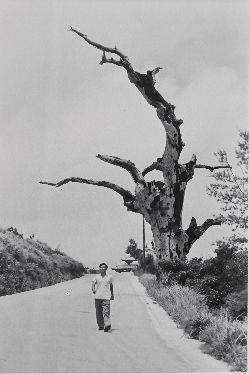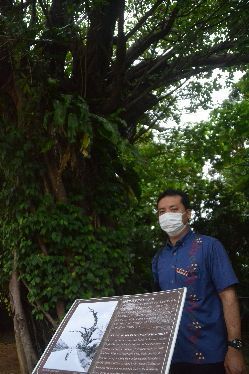1960 photograph by Tokyo photographer Tsukamoto showing indominable Akagi tree ravaged by war added to Shuri Castle signboard

The Akagi tree photographed by photographer Fumio Tsukamoto in 1960. The tree was burned in the war and only the withered stump remained. (Photograph provided by Mr. Tsukamoto.)
November 3, 2020 Ryukyu Shimpo
By Ryota Shimabukuro
Recently, a photograph taken by photographer Fumio Tsukamoto, of Tokyo, in 1960 was added to the signboard in front of a large Akagi tree in Shuri Castle Park in Naha, the withered trunk of which remained even after being ravaged during the Battle of Okinawa. The photograph shows the tree and, in the background, the Shureimon gate, which had just been restored. Now, Akou trees are epiphytically growing out of the withered Akagi trunk, and at a glance it is not clear that the trunk was an Akagi tree. “This photograph showing the scene at that time is very precious,” a coordinator at Shuri Castle Park said.
The photograph was added to the signboard in August. According to a coordinator at Shuri Castle Park, the status of the signboard is “temporarily installed,” and the prefectural government, which manages the site, plans to newly install an official signboard.
The photograph that was added was taken by photographer Tsukamoto in 1960 when he visited Okinawa. In it, a man is walking by the withered tree that was burned in the Battle of Okinawa, and in the background can be seen the Shureimon gate, which was rebuilt in 1958, the first of all Shuri Castle structures to be rebuilt after being burned down in the war.

The temporarily installed signboard. The photograph of the Akagi taken in 1960 was added. In the background can be seen the epiphytic Akou trees that grew large out of the remaining Akagi stump. Photograph taken on October 23 at Shuri Castle Park in Naha.
The Akagi tree was later damaged by a typhoon, and the middle of the trunk and the branches broke off, leaving only a stump. Meanwhile, the trunks and branches of the epiphytic Akou trees that grew around it shot up, growing into large trees in a fascinating manner in which they appear to be one with the Akagi tree.
“The Akagi tree that remained standing even after being burned and withered by the ravages of war represents the indominable spirit of the people of Okinawa. It is now the central pillar supporting the parasitic Akou trees, but at the thoughtful discretion of the managers, it has been reborn at its original location,” said Tsukamoto.
During his visit to Okinawa in 1960, Tsukamoto also took other photographs around Shuri Castle, and he donated some of them to Shuri Castle Park. “In 1960, there were still few Okinawans who owned cameras, so these photographs showing scenes from that time are very precious. I would like to hold a photography exhibit of Tsukamoto’s work showing the area around Shuri Castle and other parts of Okinawa at that time,” said Tomoki Uho of Shuri Castle Park.
(English translation by T&CT and Sandi Aritza)
Previous Article:“I want to drink Awamori over Antarctic ice!” University of the Ryukyus Staff Junji Kinjo selected to join Antarctic expedition
Next Article:“Don’t give up hope” teen leukemia survivor wins essay contests sharing her battle
[Similar Articles]
- Elementary school pupils plant trees for later use as lumber to rebuild Shuri Castle
- Six Dojos come together to perform Karate demonstration praying for the Shuri Castle reconstruction and to give courage to the region
- 400 year-old Sagaribana blooms in Okinawa
- Old procession unrolls like a scroll from the Ryukyu Kingdom era at Shurijo Castle Festival
- Shuri Castle’s main hall and north hall completely burned down with fire spreading to other buildings
 Webcam(Kokusai Street)
Webcam(Kokusai Street)


